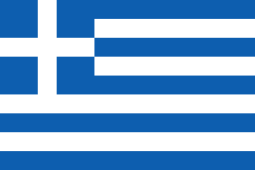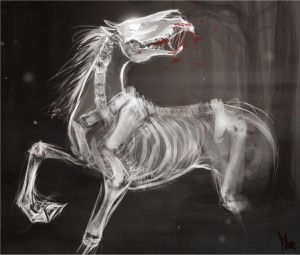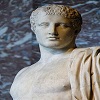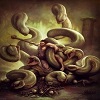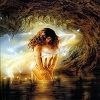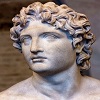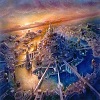Taraxippoi
The horse disturber
GHOST HUNTERS: HIPPODROME SPECIAL
Hippodromes were Greek stadiums used for horse and chariot racing, with a semi-circular end on one side, and a square end and portico on the other. Posts called termai were stationed at either end of the track, and race rules required horse-drawn chariots to pass around the outside of the posts at each end.
The passage around these posts was considered the most dangerous area of the track… not just because of the sharp turn, the reduced width, and the speed the horses would be asked to take the curve, no…but because this is where the Taraxippus made its appearance.
The Greeks were so frightened of the Taraxippus that they actually placed an altar to it (or him, depending on who’s telling the story) at this part of the track. Even the most skilled chariot drivers put themselves at risk of wrecking—and ultimately, death—when rounding this part of the course, because one never knew when the Taraxippus might appear.
Translated from the Greek, Taraxippus—plural, Taraxippoi—literally means “horse disturber.” The being was so named because this mysterious presence was thought to sit at the end of the track in wait for the chariots during races.
When the drivers guided their horses around the termai, the Taraxippus would then, in some unknown way, strike terror into the hearts of horses, sending them into a wild frenzy of fear! And when you’re driving a high-speed chariot, that doesn’t tend to end well for anyone.
DESTINATION TARAXIPPUS
The ancient Greek writers had differing opinions on what the Taraxippus actually was, of course. Pausanias, an ancient Greek geographer, saw the term as an epithet rather than an actual entity—in that it referred to the place on the hippodrome track where the horses were scared, instead of referring to a creature that scared the horses. His description of the most terrifying and deadly Taraxippus, the Taraxippus Olympios at Olympia’s hippodrome, reads as such in his work Description of Greece:
“The race-course [of Olympia] has one side longer than the other, and on the longer side, which is a bank, there stands, at the passage through the bank, Taraxippos, the terror of the horses. It has the shape of a round altar, and as they run along the horses are seized, as soon as they reach this point, by a great fear without any apparent reason.
The fear leads to disorder; the chariots generally crash and the charioteers are injured.”
He goes on to explain how the Greeks “differ in their view of Taraxippos,” with some believing that the inciting location at Olympia’s hippodrome is overtop the tomb of Olenios—a man who was highly skilled with horses—who haunts the place after death.
Another theory on the creature’s ghostly origins, also put forth by Pausanias, is that Dameon—a figure who helped Herakles in his fight against the Eleans—was killed alongside his horse in that location at Olympia, with both man and horse buried in the same tomb there.
And if those aren’t enough theories for you, Pausanias goes on to put forth four more theories on this particular spot—including one of a bitter chariot-driver who didn’t win the race, and thus continues to haunt the track so that no one else can win either—while continuing to assert that there’s no such thing as a ghost, “for heaven in every activity of man bestows either better fortune or worse. But the race course itself is not of a nature to startle the hoses, either by reason of a hero or on any other account.”
PARANORMAL EQUINE-VESTIGATIONS
But what fun is that? Pausanias, while very descriptive in his accounts of the Taraxippoi and various hippodromes around Greece, neglects the one thing that many of the Greeks adored: Drama. And what’s more dramatic than a ghost that scares horses in the middle of an intensely dangerous race?
A Roman poet in the 1st century A.D. took up the standard for this ghostly phantom, and included a description of the creature in his epic, Thebaid. According to Statius, the Taraxippoi possessed a “terrible visage to behold…endowed with countless terrors” that would have struck fear even into the hearts of the Eumenides (Greek deities of vengeance), not to mention sending Ares’ own horses into a terrified frenzy:
“When golden Arion saw it, his mane leapt up erect, and he halts with upreared shoulders and hold high suspended his yoke-fellow and the steeds that shared his toil on either side.”
Well, that sounds problematic.
FACT OR FAKED: HIPPODROME FILES
Regardless of whether or not you believe in ghosts, something about end of the hippodrome track spooked horses on a regular basis, resulting in crashes, deaths, and plenty of speculation over why this kept happening.
The skeptic will return time and time again to the explanations of “speed” and “tight corners,” but the believers among you know the truth…Greek race tracks were home to ghosts that happened to enjoy scaring horses. Not people. Just horses.
Strange as it may seem, it’s also a terribly convenient belief, particularly for bad chariot drivers who needed an excuse as to why they couldn’t control their horses around the curve…but it’s even more convenient for fantasy writers looking for a plot device that gets the story moving, while staying historically, er, accurate.
After all, why settle for a boring old regular ghost when you can have one that sends your hero’s horses into a frenzy at the most inopportune moments? Pausanias may be rolling in his grave, certainly…but at least he’s not buried at the end of a race track, wondering why the chariots stopped rolling by.
[1]

